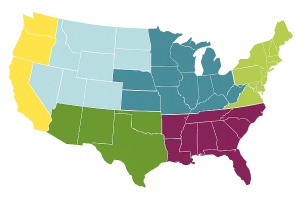How To Grow Lupine
Posted By American Meadows Content Team on Feb 13, 2017 · Revised on Oct 14, 2025

Knowing your location helps us recommend plants that will thrive in your climate, based on your Growing Zone.
Posted By American Meadows Content Team on Feb 13, 2017 · Revised on Oct 14, 2025
Once you’ve successfully grown Lupines, you’re likely to be hooked for life. You will love the outstanding color of densely-packed flower spikes, and the palmate foliage also graces the garden with fabulous texture and form.
Lupines are deer resistant and make a great addition to a low-maintenance meadowscape or cottage-style garden. Lupines attract bees and butterflies of all sorts with their multi- and bi-colored flowers, and are a great choice for pollinator gardens.
Lupines are a legume, which means that they fix nitrogen in the soil and they enrich your soil health. Intensively planting lupine can increase your soil fertility.
Some of our favorite native wildflowers across the United States are in the Lupine family, from the famous Texas Bluebonnet (L. texensis), to the eye-popping displays of violet-blue Arroyo Lupines (L.succulentus). Perennial Lupine (L. perennis), the classic favorite is still wildly popular, as are the impressively colorful Russell Lupine hybrids (L. polyphyllus), bred from Perennial lupines during the 20th century.
Annual Lupines, including Texas Bluebonnets and Arroyo Lupines, have a one-year lifecycle. In warmer climates with the right growing conditions, they may reseed. In colder climates where plants can't overwinter, it's best to reseed each year.
Perennial Lupine and Russell Lupine are perennials, so these plants will return year after year from their established root systems.
Choose a sunny site with average, well-draining soil. Lupines are legumes and can improve a soil’s fertility over time.
Light: Full sun is preferred. Lupine can grow in part shade, but flowering will be lessened.
Soil: Lupine needs well-draining soil above all else. They prefer soil on the acid side and will not tolerate high levels of alkalinity or water-logged conditions. Russell hybrids (L. polyphyllus) have more tolerance for moist conditions than many other species. Avoid sites where plants will suffer from wet soil during the winter months.
Spacing: If broadcasting seed, broadcast at a rate of approximately 1 pound per 1000 feet. If planting mature plants, space larger varieties 2-3’ apart, smaller varieties 12-18” apart.
Lupines are deep-rooted and do not spread except through re-seeding. Seeds will not come true to the original variety planted, but will eventually revert to blue-violet and white.
Planting:
The most important thing to note before planting Lupines, is that they are available as both annuals and perennials. While Lupine seeds may yield both annual (life cycle complete in one growing season) and perennial (long-lived, coming back each spring) varieties, potted Lupine plants are typically perennial cultivars.

Tips For Growing Lupine Plants:
Tips For Growing Lupine Seeds:
Growth Habit: These spring-blooming beauties are not tolerant of high heat or humidity. Lupine has a rounded habit and grows from 12-48” high depending on species or variety. Individual flowers resemble those of peas and are densely packed on spikes above the foliage.
Staking: Tall Lupines stand very straight on their own and do not require staking. For Russell species grown in garden settings, you may want to stake flower spikes if you live in an area with high winds.
Watering: For the first few months, make sure that Lupine plants are getting adequate water for good root development (they are deeply rooted), but let the soil dry out between waterings. After that, water only during periods of drought or very dry spells.
Fertilizing & Mulching: Extra fertilizing is not necessary, but a top dressing of compost is appreciated for perennials, as long as it isn’t placed close to the crown of the plant.
Trimming & Pruning: Lupines can bloom again lightly on side shoots if immediately deadheaded. However, if seeds have begun to form in the lower parts of the flower, they are unlikely to repeat their bloom.
Dividing & Transplanting: Lupines have deep roots and do not transplant well as they get bigger. Lupines do not need to be divided.
Pests & Disease: Lupine can suffer from powdery mildew, particularly in hot and humid climates. There are no other major pests for this plant besides pill bugs (roly-polys, sow bugs) which like to eat the seeds and seedlings.
Additional Concerns: Lupine seeds are actually cultivated as a food crop in some areas of the world, however, we do not recommend using these seeds in any culinary way.